
|

|

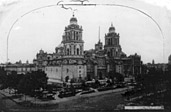 |
 |
| Mexico City
cathedral photographed between 1884-1885 by William Henry Jackson.
Library of Congress. |
|
Trail Narrative: Legacy & Conclusion
 
With the death of John Horse in Mexico City and subsequent securing of the
Nacimiento land grant, the nineteenth-century odyssey of the Black Seminoles came to a close.
Yet their story continued to echo across the frontier and in the lives of other historical figures.
|
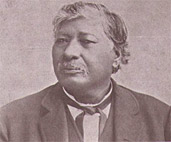 |
 |
| Seminole
Chief John Jumper, photographer and date unknown. Seminole
Nation of Oklahoma, Historic Preservation Office. |
|
In Oklahoma, the Seminole Indian leadership, which had briefly been favorable to the Black Seminoles after the
U.S. Civil War, returned to John Jumper, a former slaveholder and supporter of the Confederacy.
Jumper rejected the idea of allowing Black Seminoles from Texas and Mexico to
return to the territory. He contended that the emigrants had forfeited all claims on the nation when they fled in 1850. Despite Jumper’s efforts, two parties of Black Seminoles had returned by 1883, settling clandestinely
among their Seminole Freedmen kin. Over the next century, ethnic tensions would ebb and flow between the Native Americans and African Americans
living within the geographic confines of the Seminole Nation. Issues of tribal status and ethnic identity remain hotly contested today.
Back to top
|
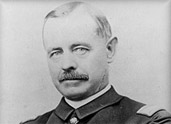 |
 |
| John Lapham
Bullis. National Archives. |
|
In 1881, John Lapham Bullis released command of the Seminole Negro Indian Scouts after the border was deemed safe. Texans gave him a sword and citations of gratitude. Bullis asked the government to give land to the scouts, first in Texas near their posts, and later in the Indian Territory. The government responded by continuing to erect bureaucratic obstacles.
A favorite officer of President Theodore Roosevelt, Bullis was promoted late in
life from major to brigadier general. He died at an army hospital in San Antonio in 1911. Upon hearing of his former commander’s death,
Scout Sandy Fay made a pilgrimage to San Antonio and stood vigil at the general’s door
for a day and a night.
Back to top
|
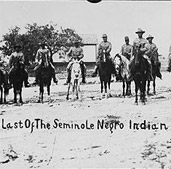 |
 |
| Detail from
"Last of the Seminole Negro Indian Scouts," 1913-1914.
Schomburg Center for Research in Black Culture. |
|
The Seminole Negro Indian Scouts remained active after 1882, but with the closing of the frontier, the group was often on the verge of being disbanded. After the Army captured Geronimo in 1886, the scouts’ activities were scaled back to policing cattle rustlers. In later years, they aided U.S.-based actions against Mexican revolutionaries. Scouts and their families continued to live as squatters on land near Fort Clark. Despite efforts from military leaders like Zenas R. Bliss, Bullis, and Ranald Mackenzie, the government never saw fit to grant land to the maroons. In 1914, the scouts were finally disbanded. The soldiers were ordered to leave the fort, and their families to leave their settlement on Las Moras Creek. The expulsion of the families, writes Kevin Mulroy, “was the ultimate expression of the deplorable treatment the United States government had dished out to the Seminole maroons since their return from Mexico.”
Scouts and their families eventually scattered around west Texas. A core remained living in Brackettville and around the fort. Today Brackettville is the spiritual center of the Black Seminole community and home to the Seminole Indian Scouts Cemetery Association, which maintains an historic graveyard for scouts and their families.
Back to top
|
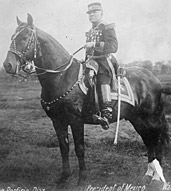 |
 |
| General
Porfirio Diaz, President of Mexico. Library of Congress. |
|
In 1887, los mascogos—the Black Seminoles who remained in Nacimiento—received an official statement from Mexican President Porfirio Diaz protecting their land grant. Mexico’s perennial instability and weak civil institutions continued to place the land under threat,
however, necessitating two more presidential decrees—from Venustiano Carranza in 1919 and Lazaro Cardenas in 1938. Cardenas added 2,892 hectares to the grant. Descendants of the mascogos remain in Nacimiento, where they live close to the Kickapoo reservation. They have long since intermarried with local Mexicans around the nearby town of Melchior de Muzquiz, and yet visitors even
today can catch sight of the occasional Afro-Mexican cowboy, conjuring images of a bygone era.
Back to top
|
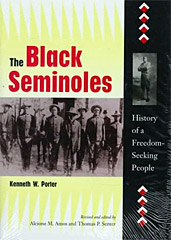 |
 |
| Black
Seminoles: History of a Freedom-Seeking People, by Kenneth
Wiggins Porter. |
|
The Black Seminoles might have been lost to
history if not for the work of a few scholars. In the nineteenth-century, after the brief popularity of Joshua Reed Giddings’ The Exiles of Florida (1858), the Black Seminoles
quickly receded as a subject of historical writing. Occasionally a popular work, like John Bach McMaster’s History of the People of the United States (1883-1913), would touch on their story. With the rise of southern revisionism during the 1890s, however, their story fell utterly out of vogue. Historians steeped in southern myths or seeking to avoid inflammatory North-South topics were not interested in black rebels who successfully fought for freedom. The Black Seminoles fell even
from the margins of American history.
Laurence Foster began to reverse the trend with the publication of a graduate thesis in 1935 on Negro-Indian Relationships in the Southeast. Despite the broad title, the book mainly focused on the Black Seminoles. It was based upon
historical research and anthropological interviews that Foster conducted in Oklahoma, Texas, and Mexico in 1929.
After Foster, Kenneth Wiggins Porter,
a business historian, became immersed in Black Seminole history. All
contemporary writers on the Black Seminoles owe an enormous debt to Porter.
His strongly narrative work, which reexamined primary sources, was enhanced
by interviews that Porter began conducting with descendants of the Black
Seminoles in Texas, Oklahoma, and Mexico in the 1940s. Porter's first articles
on the Black Seminoles appeared in the 1940s in the Journal of Negro Studies and
other periodicals that were seeking to depict U.S. racial history with more
accuracy and less mythology. Many of the articles were collected in The Negro on
the American Frontier, which Porter edited in 1971. A significant portion of
Porter's work remains unpublished, housed in the Kenneth Wiggins Porter
Collection at the Schomburg Center for Research in Black Culture. His scholarly
contributions culminated with the posthumous publication, 15 years after his death, of Black Seminoles: History of a Freedom-Seeking People
(1996). The book was edited by Alcione Amos and Thomas Senter, who continue to promote Black Seminole history.
Senter advised this project when it was initially conceived as a television
documentary.
Porter’s combined scholarship influenced all of the subsequent writings on the Black Seminoles, from groundbreaking studies like Daniel Littlefield’s Africans and Seminoles and Kevin Mulroy's
Freedom on the Border to scholarly contributions from Bruce Edward Twyman,
even popular musings by Alice Walker. More recently, the scholarly and popular works have been augmented by references to the Black Seminoles in films,
in John Sayles’ Lone Star and Danny Glover’s Buffalo Soldiers.
Back to top
|
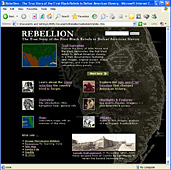 |
 |
| Home page of
Rebellion Web site, www.johnhorse.com |
|
Despite the miniature flowering of Black Seminole awareness over the past decade, historical reference works—and major scholars—remain blissfully unaware
of the scope of the slave rebellion that the maroons inspired and led. Likewise
their impact on the American abolitionist movement remains poorly understood at best, and generally ignored. Their minor but substantive impact on emancipation has been entirely overlooked. The original scholarship in this Web documentary attempts to amend these final three omissions in particular,
while documenting the story, placing it within the mainstream of the American
experience, and making it accessible to general audiences.
On to Conclusion>>
Back to top
|
| |
Sources: Porter Black 194-195, 208-13, 225, Mulroy 155, 168-169.
©
Part
5, Legacy &
:
l
|
| |
   
|
|
|